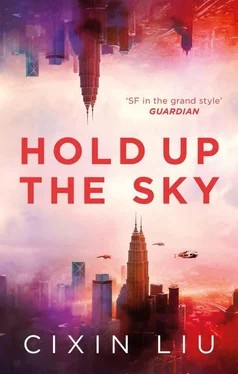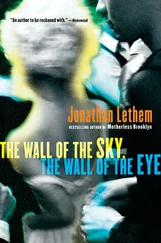Лю Цысинь - Hold Up the Sky
Здесь есть возможность читать онлайн «Лю Цысинь - Hold Up the Sky» весь текст электронной книги совершенно бесплатно (целиком полную версию без сокращений). В некоторых случаях можно слушать аудио, скачать через торрент в формате fb2 и присутствует краткое содержание. Город: London, Год выпуска: 2020, ISBN: 2020, Издательство: Head of Zeus, Жанр: Фантастика и фэнтези, на английском языке. Описание произведения, (предисловие) а так же отзывы посетителей доступны на портале библиотеки ЛибКат.
- Название:Hold Up the Sky
- Автор:
- Издательство:Head of Zeus
- Жанр:
- Год:2020
- Город:London
- ISBN:978-1-83893-763-8
- Рейтинг книги:4 / 5. Голосов: 1
-
Избранное:Добавить в избранное
- Отзывы:
-
Ваша оценка:
- 80
- 1
- 2
- 3
- 4
- 5
Hold Up the Sky: краткое содержание, описание и аннотация
Предлагаем к чтению аннотацию, описание, краткое содержание или предисловие (зависит от того, что написал сам автор книги «Hold Up the Sky»). Если вы не нашли необходимую информацию о книге — напишите в комментариях, мы постараемся отыскать её.
Hold Up the Sky — читать онлайн бесплатно полную книгу (весь текст) целиком
Ниже представлен текст книги, разбитый по страницам. Система сохранения места последней прочитанной страницы, позволяет с удобством читать онлайн бесплатно книгу «Hold Up the Sky», без необходимости каждый раз заново искать на чём Вы остановились. Поставьте закладку, и сможете в любой момент перейти на страницу, на которой закончили чтение.
Интервал:
Закладка:
We boarded a metallic, small-gauge segmented vehicle, like an early train, only much smaller and powered by an overhead wire. The vehicle started up and soon we entered the black mouth of a cave. It was very dark inside, with only an occasional dim lamp above us. Our headlamps were weak as well, only enough to make out the faces right beside us. The wind was strong and whistled in our ears; it felt like we were dropping into an abyss.
“We’re going down the mine now, students!” the teacher said.
After a long while, the vehicle stopped. We passed from this relatively wide tunnel into a considerably thinner and smaller spur, and if not for my helmet, I would have knocked a few lumps in my head. Our headlamps created small patches of light but we couldn’t see anything clearly. Students shouted that they were scared.
After a while, the space opened up in front of us. Here the ceiling was supported by lots of columns. Opposite us, there were many points of light shining from lamps like the ones on our helmets. As we drew closer, I saw lots of people were at work, some of them making holes in the cave wall with a long-bore drill. The drills were powered by some sort of engine whose sound made my skin crawl. Other people with metal shovels were shoveling some sort of black material into railcars and leather satchels. Clouds of dust occasionally blocked them, and lanterns cast shafts of light through the dust.
“Students, we’re now in what’s called the ore zone. What you see is a scene of early mining work.”
A few miners came toward us. I knew they were holograms, so I didn’t move out of the way. Some of them passed through me, so I could see them very clearly, and I was astonished.
“Did China hire black people to mine coal?”
“To answer that question,” the teacher said, “we’ll have a real experience of the air of the ore zone. Please take out your breathing masks from your bags.”
We put on our masks, and heard the teacher say, “Please remember that this is real, not a hologram.”
A cloud of black dust came toward us. In the beams from our headlamps I was shocked to see the thick cloud of particles sparkling. Then someone started to scream, and like a chorus, a lot of other kids screamed as well. I turned to laugh at them, but I, too, yelped when I got a look: Everyone was completely black, apart from the portion the masks covered. Then I heard another shout that turned my hair on end: It was the teacher’s voice!
“My god, Seya! You don’t have your mask on!”
Seya hadn’t put on his mask, and now he was as completely black as the holographic miners. “You said over and over in history class that the key goal was to get a feel for the past. I wanted a real feel!” he said, his teeth flashing white on his black face.
An alarm sounded somewhere, and within a minute, a teardrop-shaped micro-hovercar stopped soundlessly in front of us, an unpleasant intrusion of something modern. Two doctors got out. By now, all of the real coal dust had been sucked away, leaving only the holographic dust floating around us, so their white coats stayed spotless as they passed through it. They pulled Seya off to the car.
“Child,” one doctor said, looking straight into his eyes. “Your lungs have been seriously harmed. You’ll have to be hospitalized for at least a week. We’ll notify your parents.”
“Wait!” Seya shouted, his hands fumbling with the rebreather. “Did miners a hundred years ago wear these?”
“Shut your mouth and go to the hospital,” the teacher said. “Why can’t you ever just follow the rules?”
“We’re human, just like our ancestors. Why…”
Seya was shoved into the car before he could finish. “This is the first time the museum has had this kind of accident,” a doctor said severely, pointing at the teacher and adding, before getting into the hovercar, “This falls on you!” The hovercar left as silently as it had come.
We continued our tour. The chastened teacher said, “Every kind of work in the mine was fraught with danger, and required enormous physical energy. For example, these iron supports had to be retrieved after extraction in this zone was completed, in a process called support removal.”
We saw a miner with an iron hammer striking an iron pin in one of the supports, buckling it in two. Then he carried it off. Me and a boy tried to pick up another support that was lying on the ground, but it was ridiculously heavy. “Support removal was a dangerous job, since the roof overhead could collapse at any time…”
Above our heads came scraping sounds, and I looked up and saw, in the light of the mining lanterns, a fissure open up in the rock where the support had just been removed. Before I had time to react, it fell in, and huge chunks of holographic stone fell through me to the ground with a loud crash. Everything vanished in a cloud of dust.
“This accident is called a cave-in,” the teacher’s voice sounded beside me. “Be careful. Harmful stones don’t always come from up above.”
Before she even finished, a section of rock wall next to us toppled over, falling a fair distance in a single piece, as if a giant hand from the ground had pushed it over, before finally breaking up and raining down as individual stones. We were buried under holographic rocks with a crash, and our headlamps went out. Through the darkness and screams, I heard the teacher’s voice again.
“That was a methane outburst. Methane is a gas that builds to immense pressure when sealed in a coal seam. What we saw just now was what happens when the rock walls of the work zone can’t hold back that pressure and are blown out.”
The lights came back on, and we all exhaled. Then I heard a strange sound, at times as loud as galloping horses, sometimes soft and deep, like giants whispering.
“Look out, children! A flood is coming!”
We were still processing what she said when a broad surge of water erupted from a tunnel not far away. It quickly swamped the entire work zone. The murky water reached our knees, and then was waist-high. It reflected the light of our headlamps to shine indistinct patterns on the rocky ceiling. Wooden beams stained black with coal dust floated by, and miners’ helmets and lunch boxes…. When the water reached my chin, I instinctively held my breath. Then I was entirely underwater, and all I could see was a murky brown where my headlamp shone, and air bubbles that sometimes floated up.
“Mine floods have many causes. Whether it’s groundwater, or if the mine has dug into a surface water source, it’s far more life-threatening than a flood above ground,” the teacher said over the sound of the water.
The holographic water vanished and our surroundings returned to normal. Then I noticed an odd-looking object, like a big metal toad puffing out its stomach. It was huge and heavy. I pointed it out to the teacher.
“That’s an anti-explosion switch. Since methane is a highly flammable gas, the switch suppresses the electric sparks that ordinary switches create. That’s related to what we’ll see next, the most terrifying mining danger of all…”
There was another loud crash, but unlike the previous two times, it seemed to come from within us, bursting through our eardrums to the outside, as huge waves contracted our every cell, and in the searing waves of heat, we were plunged into a red glow emitted from the air around us that filled every inch of space in the mine. Then the glow disappeared, and everything plunged into darkness.
“Few people have actually seen a methane explosion, since it’s hard to survive one in the mines.” The teacher’s disembodied voice echoed in the darkness.
“Why did people used to come to such a terrible place?” a student asked.
“For this,” the teacher said, holding a chunk of black rock into the light from our headlamps, where its innumerable facets sparkled. That was the first time I saw solid coal.
Читать дальшеИнтервал:
Закладка:
Похожие книги на «Hold Up the Sky»
Представляем Вашему вниманию похожие книги на «Hold Up the Sky» списком для выбора. Мы отобрали схожую по названию и смыслу литературу в надежде предоставить читателям больше вариантов отыскать новые, интересные, ещё непрочитанные произведения.
Обсуждение, отзывы о книге «Hold Up the Sky» и просто собственные мнения читателей. Оставьте ваши комментарии, напишите, что Вы думаете о произведении, его смысле или главных героях. Укажите что конкретно понравилось, а что нет, и почему Вы так считаете.











